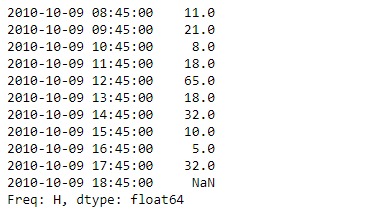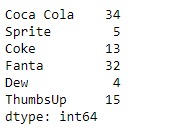Pandas 系列是带有轴标签的一维ndarray。标签不必是唯一的,但必须是可哈希的类型。该对象同时支持基于整数和基于标签的索引,并提供了许多方法来执行涉及索引的操作。
Pandas Series.autocorr()函数计算lag-N自相关。该方法计算级数及其移位后的自我之间的皮尔逊相关性。
用法: Series.autocorr(lag=1)
参数:
lag:执行自相关之前要应用的滞后次数。
返回:浮点数
范例1:采用Series.autocorr()函数来计算给定系列对象的基础数据的lag-N自相关。
# importing pandas as pd
import pandas as pd
# Creating the Series
sr = pd.Series([11, 21, 8, 18, 65, 18, 32, 10, 5, 32, None])
# Create the Index
index_ = pd.date_range('2010-10-09 08:45', periods = 11, freq ='H')
# set the index
sr.index = index_
# Print the series
print(sr)输出:

现在我们将使用Series.autocorr()函数来计算给定系列对象的基础数据的lag-n自相关。
# return the auto correlation
result = sr.autocorr()
# Print the result
print(result)输出:

正如我们在输出中看到的,Series.autocorr()函数已成功将给定系列对象的基础数据的自动相关性延迟1返回。
范例2:采用Series.autocorr()函数来计算给定系列对象的基础数据的lag-N自相关。取滞后值等于3。
# importing pandas as pd
import pandas as pd
# Creating the Series
sr = pd.Series([34, 5, 13, 32, 4, 15])
# Create the Index
index_ = ['Coca Cola', 'Sprite', 'Coke', 'Fanta', 'Dew', 'ThumbsUp']
# set the index
sr.index = index_
# Print the series
print(sr)输出:

现在我们将使用Series.autocorr()函数来计算给定系列对象的基础数据的lag-n自相关。
# return the auto correlation
# by lag-3
result = sr.autocorr(lag = 3)
# Print the result
print(result)输出:

正如我们在输出中看到的,Series.autocorr()函数已成功将给定系列对象的基础数据的自动相关性延迟1返回。
相关用法
- Python pandas.map()用法及代码示例
- Python Pandas Series.str.len()用法及代码示例
- Python Pandas.factorize()用法及代码示例
- Python Pandas TimedeltaIndex.name用法及代码示例
- Python Pandas dataframe.ne()用法及代码示例
- Python Pandas Series.between()用法及代码示例
- Python Pandas DataFrame.where()用法及代码示例
- Python Pandas Series.add()用法及代码示例
- Python Pandas.pivot_table()用法及代码示例
- Python Pandas Series.mod()用法及代码示例
- Python Pandas Dataframe.at[ ]用法及代码示例
- Python Pandas Dataframe.iat[ ]用法及代码示例
- Python Pandas.pivot()用法及代码示例
- Python Pandas dataframe.mul()用法及代码示例
- Python Pandas.melt()用法及代码示例
注:本文由纯净天空筛选整理自Shubham__Ranjan大神的英文原创作品 Python | Pandas Series.autocorr()。非经特殊声明,原始代码版权归原作者所有,本译文未经允许或授权,请勿转载或复制。
